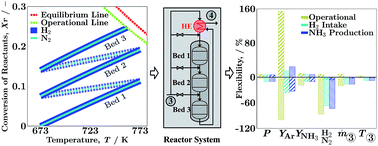Operating envelope of Haber–Bosch process design for power-to-ammonia†
Abstract
The power-to-ammonia concept allows for the production of ammonia, one of the most produced inorganic chemicals, from air, water and (renewable) electricity. However, power-to-ammonia requires flexible operation for use with a directly intermittent renewable energy supply. In this paper, we systematically analyse the operating envelope for steady-state operation of the three bed autothermic Haber–Bosch reactor system for power-to-ammonia by pseudo-homogeneous model. Operational flexibilities of process variables, hydrogen intake and ammonia production flexibilities are analysed, along with maximum and minimum possible changes in recycle load and recycle to feed ratio for the following process variables: reactor pressure, inert gas percentage in synthesis loop, NH3 concentration, H2-to-N2 ratio, total flow rate and feed temperature. Among the six process variables, inert gas fraction and H2-to-N2 ratio provided very high flexibilities, ca. 255% operational flexibility for Ar, up to 51 to 67% flexibility in hydrogen intake, and up to 73% reduction and 24% enhancement in ammonia production. However, a decrease in ammonia production by H2-to-N2 ratio significantly increases recycle load. Besides inert gas fraction and H2-to-N2 ratio, the total mass feed flow rate is also significant for minimum hydrogen intake and ammonia production.



 Please wait while we load your content...
Please wait while we load your content...